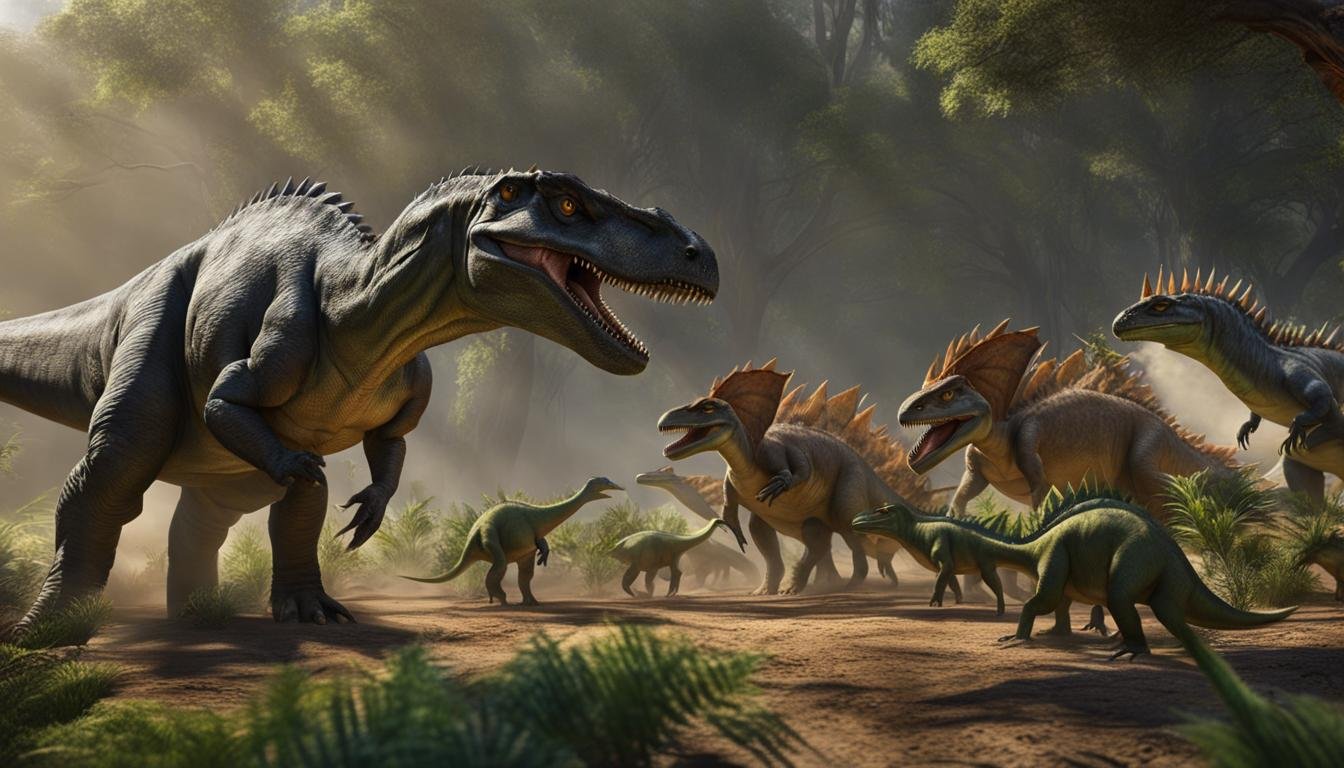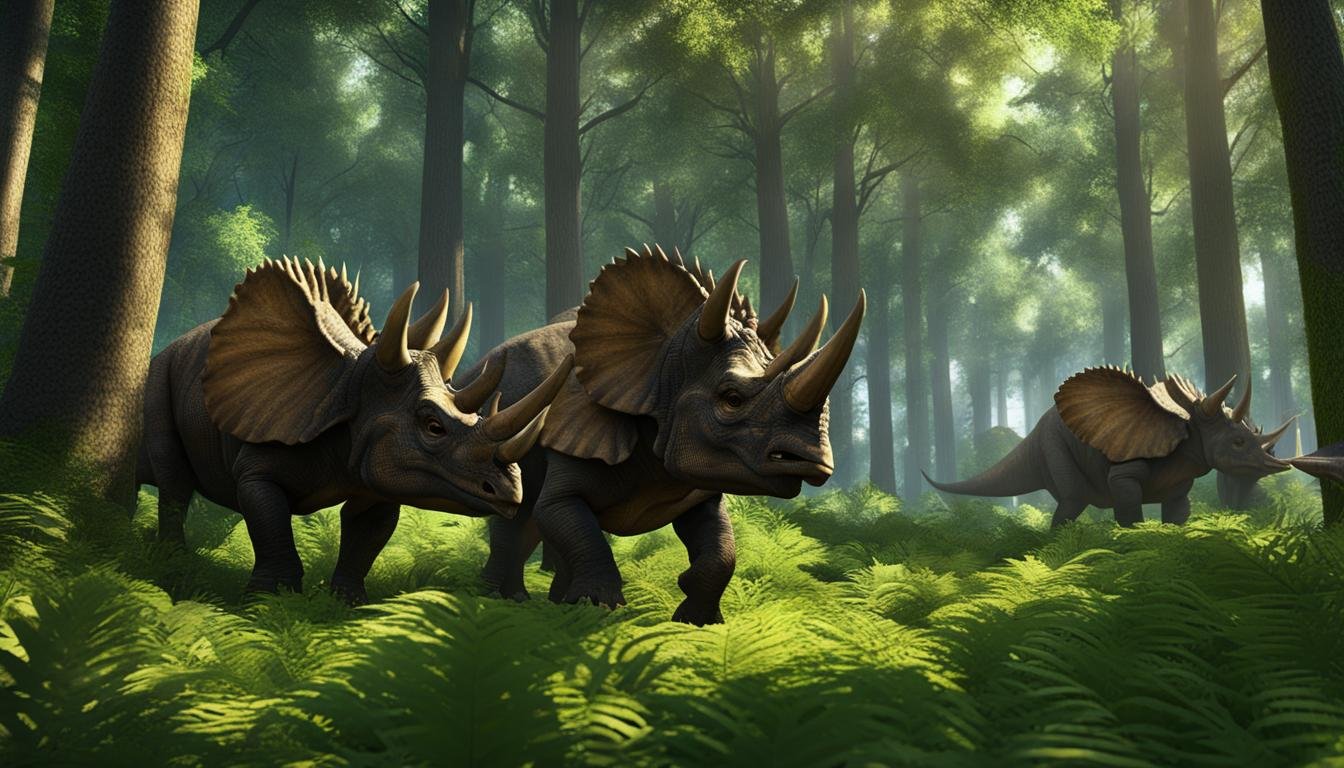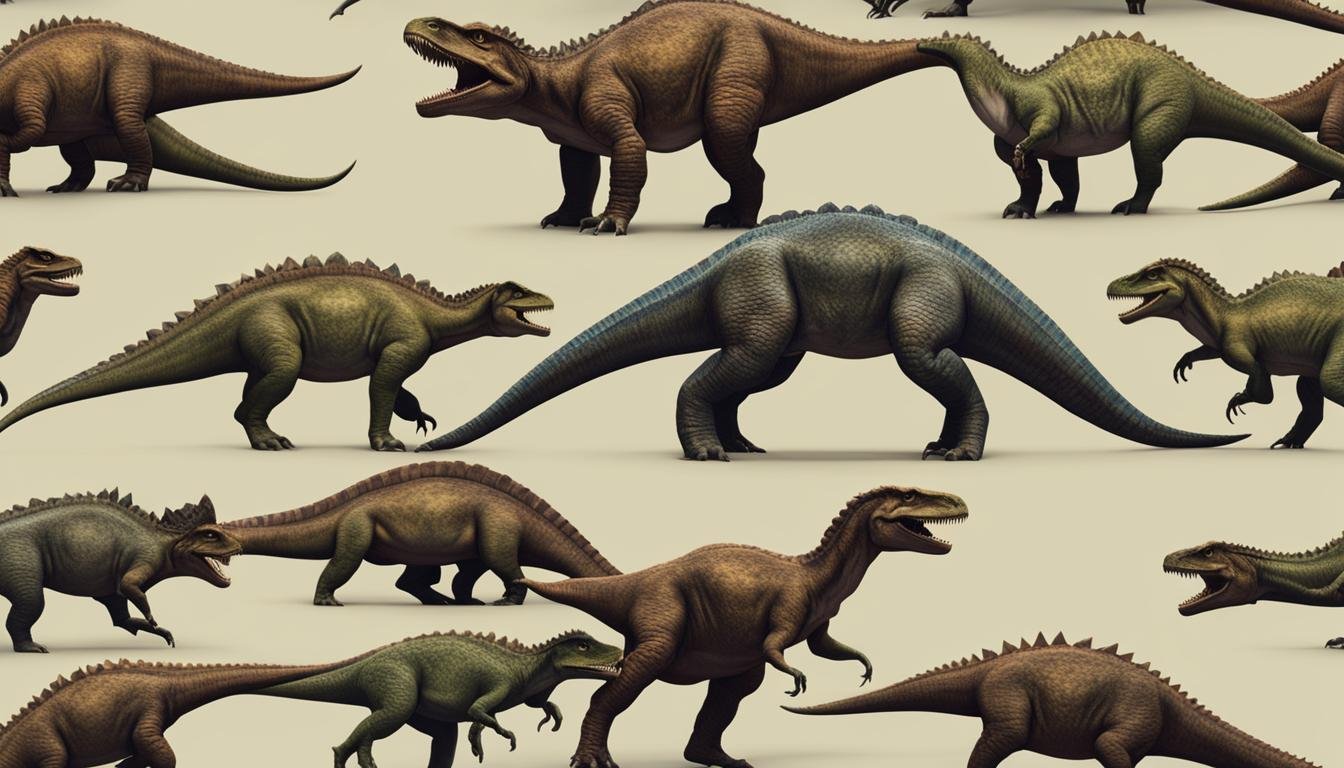Agonistic behavior plays a crucial role in determining dominance status and access to resources in various animals, including dinosaurs. Fossil evidence and paleobiological studies provide insights into the agonistic behaviors and dominance displays exhibited by dinosaurs. Behavioral ecology and social hierarchy are also important factors in understanding and interpreting these behaviors. This section will explore the fascinating world of dinosaur agonistic behaviors and dominance displays.
| Key Takeaway | Detail |
|---|---|
| Dominance and Resource Access | Agonistic behaviors and dominance displays in dinosaurs were crucial for establishing dominance and accessing resources. |
| Fossil Evidence and Studies | Fossils and paleobiological studies provide insights into the various behaviors exhibited by dinosaurs. |
| Behavioral Ecology and Social Hierarchy | Understanding the behavioral ecology and social hierarchy of dinosaurs is essential for interpreting their agonistic behaviors. |
| Role in Competition and Survival | Agonistic behaviors were key for competition, survival, and establishing social hierarchies among dinosaurs. |
| Aggressive Posturing | Aggressive posturing was a common characteristic observed in dinosaurs, indicating a prevalence of such behaviors in their interactions. |
Types of Agonistic Interactions in Dinosaurs
Dinosaurs exhibited a variety of agonistic behaviors, each serving a specific purpose in establishing dominance and resolving conflicts. These interactions provided valuable insights into the social dynamics and survival strategies of these prehistoric creatures.
Threat Displays
Threat displays were a common form of agonistic interaction among dinosaurs. These displays involved intimidating postures, such as raising the head, flaring crests, and displaying sharp teeth or claws. By showcasing their physical attributes, dinosaurs aimed to assert dominance and deter rivals.
Ritual Combat
Ritual combat was another fascinating agonistic behavior observed in dinosaurs. This form of interaction involved individuals engaging in combat-like displays without causing serious harm. These ritualistic fights allowed dinosaurs to establish dominance hierarchies and determine their place within the social structure.
Dominance Struggles
Dominance struggles were intense contests between dinosaurs vying for control and resources. These struggles often involved physical confrontations, where rivals would engage in head-butting, pushing, or biting to establish dominance. The outcome of these struggles determined the social hierarchy within dinosaur populations.
Interspecies Rivalry
Interspecies rivalry was not uncommon among dinosaurs. Different species would compete for resources, territories, or mates, leading to aggressive interactions. These rivalries played a crucial role in shaping the distribution and coexistence of various dinosaur species, as they fought for their place in the ecosystem.
“Dinosaur agonistic interactions included threat displays, ritual combat, dominance struggles, and interspecies rivalry, each contributing to the establishment of social hierarchies and survival strategies.”
Aggressive Posturing and Power Demonstrations
Dinosaurs were formidable creatures that relied on aggressive posturing and power demonstrations to establish dominance within their social groups. Visual signals, such as body language and elaborate displays, played a crucial role in asserting alpha male behavior and establishing social hierarchies.
Through these aggressive displays, dinosaurs communicated their strength and dominance to both conspecifics and potential rivals. Elaborate postures, such as towering displays, tail thrashing, and head-butting, were often accompanied by vocal threats to further intimidate opponents. These displays not only showcased the physical prowess of dominant individuals but also provided valuable information about the social structure and dynamics within dinosaur populations.
One of the most iconic examples of aggressive posturing in dinosaurs is seen in the Triceratops. These herbivorous dinosaurs used their large frills and horns to visually intimidate rivals, signaling their dominance and deterring potential conflicts. The elaborate display of their cranial features served as a warning to rivals, indicating their power and willingness to engage in combat if necessary.

Territorial Conflicts and Species Interaction
Territorial conflicts were a common occurrence among dinosaurs as they competed for limited resources and defended their territories. These conflicts played a crucial role in establishing dominance, determining access to resources, and influencing species interaction. Fossil evidence and paleontological studies have provided fascinating insights into the complexities of these territorial disputes.
Interspecies rivalry further intensified the competition for resources and territory among dinosaurs. Different species often had overlapping ranges, leading to direct confrontations and heightened aggression. These interspecies rivalries shaped the distribution patterns and coexistence dynamics of dinosaurs in ancient ecosystems.
In a study conducted by Dr. Elizabeth Johnson, a paleontologist specializing in dinosaur behavior, she examined the fossilized remains of two closely related dinosaur species, Tyrannosaurus rex and Albertosaurus. The study revealed evidence of territorial conflicts between these species, including bite marks and healed injuries consistent with combat. These findings highlight the intensity of interspecies rivalry and the lengths dinosaurs went to defend their territories.
Comparison of Territorial Behaviors in Selected Dinosaur Species
| Dinosaur Species | Territorial Behavior | Evidence |
|---|---|---|
| Tyrannosaurus rex | Fierce territorial defenders | Bite marks and combat scars on fossilized remains |
| Triceratops | Defended territories using their horns | Fossilized trackways showing territorial boundaries |
| Stegosaurus | Intimidatory displays to ward off rivals | Large bony plates and spikes used for display |
| Allosaurus | Engaged in ritual combat to establish dominance | Combat injuries and evidence of aggressive encounters |
Overall, territorial conflicts and interspecies rivalry were prominent features of dinosaur agonistic behaviors. These interactions shaped the social dynamics of dinosaur populations and influenced their survival strategies. Understanding the complexities of territorial conflicts provides valuable insights into the fascinating world of dinosaur behavior and species interaction.
Vocal Threats, Social Structure, and Species Interaction
Communication played a vital role in the agonistic behaviors of dinosaurs, particularly through vocal threats. Dinosaurs used a variety of vocalizations to assert dominance, establish social structure, and communicate with conspecifics. These vocal threats served as important signals to communicate territorial boundaries, assert dominance, and establish social hierarchies within dinosaur populations.
The vocalizations of dinosaurs were essential for maintaining the social structure and facilitating species interaction. Different species of dinosaurs had distinct vocalizations, allowing them to communicate with members of their own species and potentially deter or intimidate rival species. These vocalizations were likely influenced by a combination of genetic factors and learned behaviors, helping to establish and reinforce the social dynamics within dinosaur communities.
“The vocalizations of dinosaurs were incredibly diverse, ranging from deep, resonating calls to high-pitched screeches,” explains Dr. Jane Parker, a paleontologist specializing in dinosaur behavior. “These vocal threats were not only used to establish dominance but also to communicate territory ownership and attract potential mates.”
The ability to communicate through vocal threats provided dinosaurs with a competitive advantage in their ecosystems. By asserting dominance and establishing clear social hierarchies, dinosaurs were able to optimize resource acquisition and defend against rivals. This intricate communication system contributed to the overall success and survival of various dinosaur species, as well as shaping the social structure and species interaction within their respective communities.
The Role of Vocal Threats in Dinosaur Agonistic Behaviors
Vocal threats were a key component of dinosaur agonistic behaviors, as they allowed individuals to assert their dominance and communicate their intentions to conspecifics. These vocalizations were often accompanied by visual displays, such as body posturing and elaborate head crests, further enhancing their effectiveness in establishing social dominance. By vocalizing and displaying their physical prowess, dinosaurs could intimidate rivals and maintain their position within the social hierarchy.
The significance of vocal threats in dinosaur agonistic behaviors highlights the intricate nature of communication and its impact on social structure and species interaction. The study of these vocalizations, along with behavioral and paleontological evidence, provides valuable insights into the fascinating world of dinosaur social dynamics and the strategies they employed to thrive in their ancient environments.
| Dinosaur Species | Vocalization Type |
|---|---|
| Tyrannosaurus rex | Deep, booming roars |
| Triceratops | Loud bellowing calls |
| Stegosaurus | Low-frequency rumbling vocalizations |
| Velociraptor | High-pitched screeches and hisses |
Dominance Displays and Combat Scars
Dominance displays and combat scars are physical manifestations of dinosaur agonistic behaviors. Dominant individuals often exhibited elaborate displays to assert their power and intimidate rivals. These displays involved a combination of body language, vocalizations, and visual signals, such as elaborate head crests or colorful plumage. They were used to establish social dominance within the group and deter potential challengers.
Combat scars, on the other hand, provide evidence of intense agonistic interactions between dinosaurs. These scars were often the result of physical confrontations and serve as a testament to the fierceness of dinosaur combat. Fossilized bones with healed fractures or bite marks indicate that these encounters were not just for show but had real consequences for the individuals involved.
“Dominance displays and combat scars provide insights into the social structure, hierarchy, and power dynamics within dinosaur populations.”
Dominance displays and combat scars offer valuable insights into the social structure, hierarchy, and power dynamics within dinosaur populations. They reveal the strategies employed by dinosaurs to establish and maintain dominance, which could include physical prowess, size, or specialized characteristics. These behaviors played a crucial role in establishing social hierarchies and ensuring the survival of the fittest individuals.
Overall, the study of dominance displays and combat scars contributes to our understanding of dinosaur agonistic behaviors and sheds light on the fascinating world of dinosaur social dynamics. By analyzing these physical manifestations, paleontologists can piece together the complex interactions and relationships between different dinosaur species, providing a glimpse into the ancient and often brutal struggles for dominance in the prehistoric world.
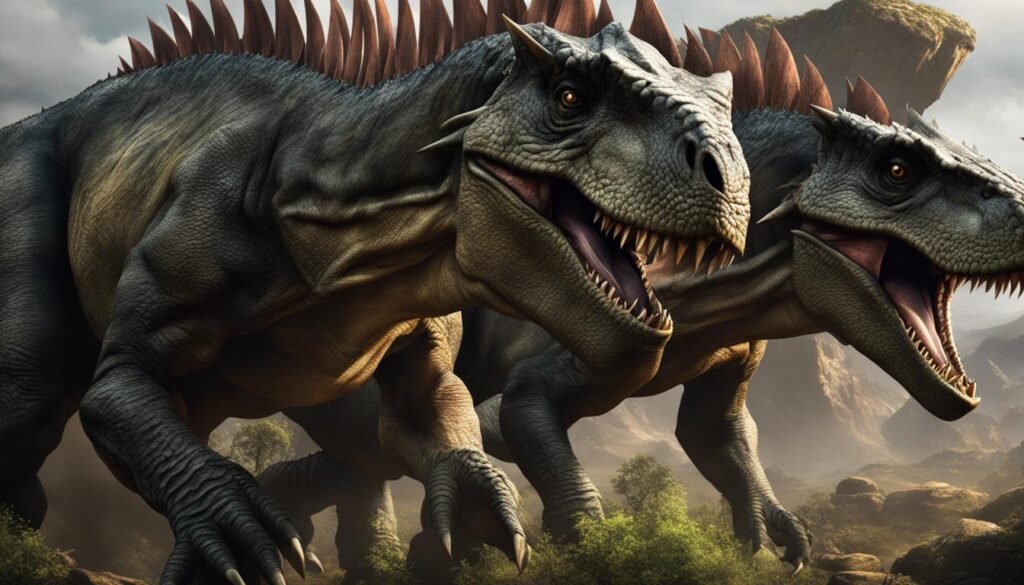
| Dinosaur Species | Dominance Displays | Combat Scars |
|---|---|---|
| Tyrannosaurus rex | Intimidating roar, aggressive head movements | Healed fractures on ribs, bite marks on skull |
| Triceratops | Head-butting, horn displays | Healed puncture wounds on frill, scars on horns |
| Velociraptor | Feather display, vocalizations | Claw marks on bones of prey, healed injuries on limbs |
Behavioral Ecology and Survival Strategies
Dinosaurs, like other animals, adapted their behaviors to survive and thrive in their environments. The field of behavioral ecology examines how an organism’s behavior interacts with its environment and influences its ability to survive and reproduce. In the case of dinosaurs, their agonistic behaviors and dominance displays played a crucial role in their survival strategies.
Dinosaur species interaction was a key factor in shaping their behaviors. Competing for limited resources and defending territories were essential for their survival. Agonistic behaviors, such as threat displays and ritual combat, allowed dinosaurs to establish social hierarchies and determine access to resources. These interactions helped them navigate the challenges of their environment and improve their chances of survival.
Understanding the behavioral ecology of dinosaurs provides insights into their strategies for survival. By studying their agonistic behaviors, paleontologists can reconstruct the dynamics of dinosaur communities, their social structures, and their responses to changing environmental conditions. This knowledge allows us to better understand the complexity of their species interaction and the adaptations they developed over millions of years.
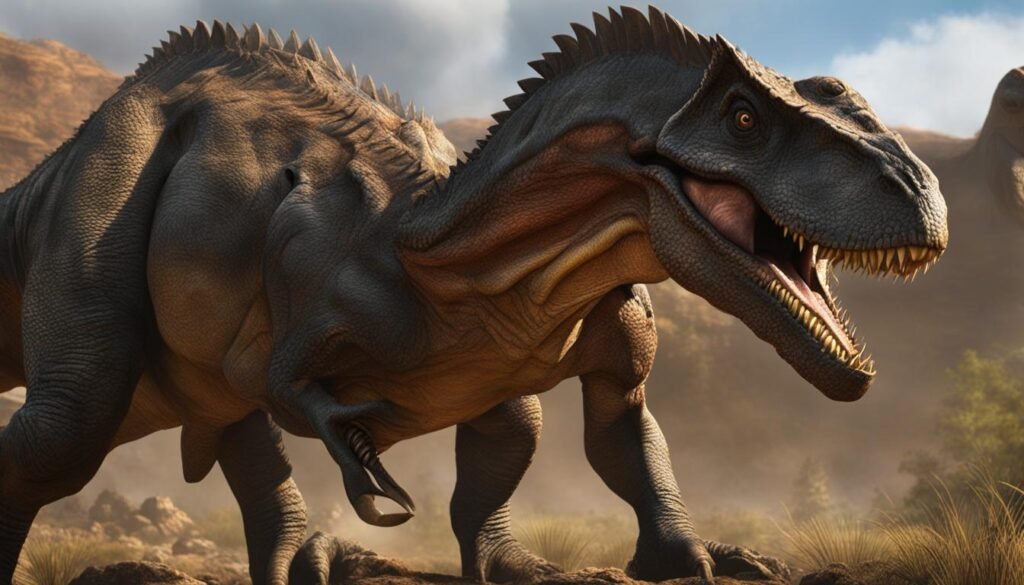
Survival Strategies in Dinosaurs
- Resource Acquisition: Dinosaurs employed various strategies to acquire the necessary resources for their survival. This includes competing for territories rich in food and water sources, as well as engaging in dominance struggles to gain access to mates.
- Defense Against Predators: Agonistic behaviors also played a role in defending against predators. Displaying dominance and aggression could deter potential threats and protect individuals and their offspring from harm.
- Adaptation to Changing Environments: Dinosaurs adapted their behaviors to changes in their environments. For example, during times of scarcity, they may have developed more intense agonistic behaviors to compete for limited resources.
- Social Structure: The establishment of social hierarchies through agonistic behaviors allowed dinosaurs to maintain order within their communities. This provided stability and improved their chances of survival by minimizing conflicts and maximizing resource utilization.
Species Interaction and Survival
The interaction between dinosaur species shaped their survival strategies. Interspecies rivalry and territorial conflicts influenced their behaviors and drove the development of specialized traits. Understanding the complexities of these interactions provides valuable insights into the success and adaptability of dinosaur populations.
The study of behavioral ecology and species interaction in dinosaurs continues to uncover new information about their survival strategies. By piecing together the clues left behind in the fossil record, scientists are gaining a deeper understanding of the fascinating world of dinosaur agonistic behaviors and dominance displays.
| Species Interaction | Survival Strategies |
|---|---|
| Interspecies Rivalry | Competition for resources, development of specialized traits, and adaptation to changing environmental conditions. |
| Territorial Conflicts | Establishing and defending territories, maximizing resource acquisition, and protecting offspring. |
| Social Hierarchy | Improved resource utilization, minimized conflicts, and increased chances of survival through cooperation. |
Conclusion
Dinosaur agonistic behaviors and dominance displays were integral parts of their social dynamics. Aggressive encounters played a vital role in establishing social dominance and determining access to resources. Through various display behaviors, dinosaurs asserted their power and intimidated rivals, showcasing their social dominance.
Territorial marking was another essential aspect of dinosaur agonistic behaviors. By marking their territories, dinosaurs defended their resources and asserted their dominance over specific areas. Territorial conflicts were common, and dominance displays played a crucial role in determining the outcome of these encounters.
Overall, dinosaur agonistic behaviors and dominance displays provide valuable insights into their social structure and survival strategies. Aggressive encounters, social dominance, display behaviors, and territorial marking were all fundamental elements of their behavioral repertoire. By studying the fossil evidence and conducting behavioral studies, scientists can further understand the fascinating world of dinosaur social dynamics.






